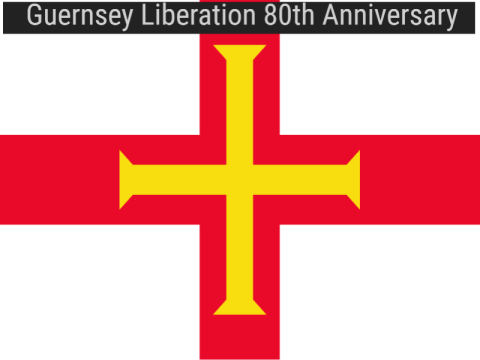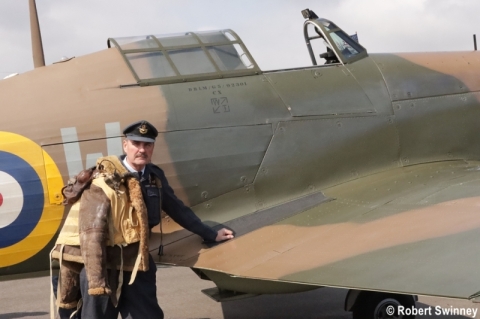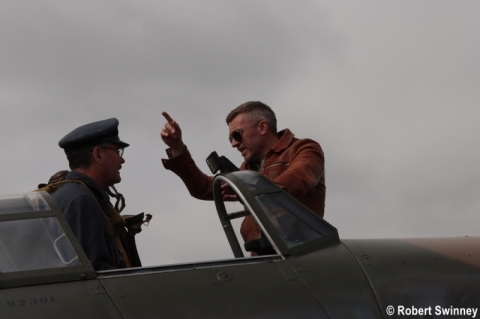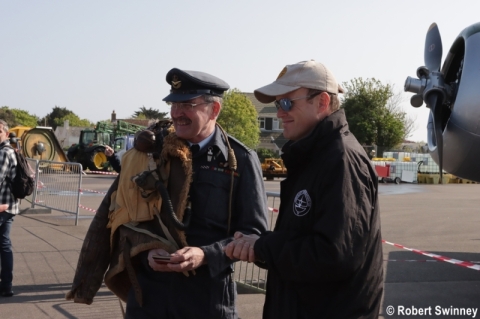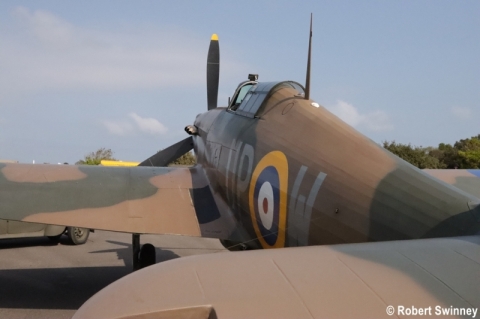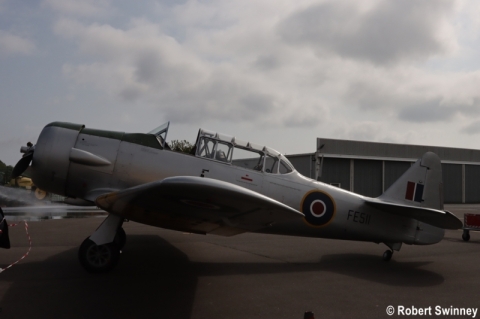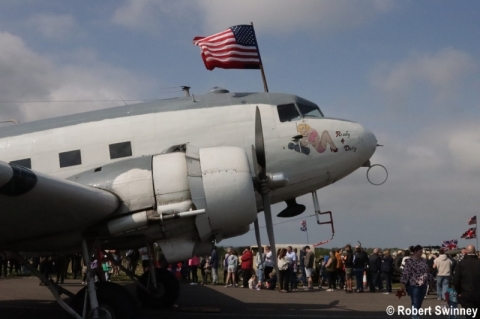News
Guernsey Liberation 80th Anniversary - Meet the Pilots event
8th May 2025

Guernsey Liberation 80th Anniversary (Source: © Robert Swinney)
USPA NEWS -
Guernsey Liberation 80th Anniversary - 8th May 2025 - Meet the Pilots event
As a prelude to the 80th anniversary of Guernsey’s Liberation from Nazi occupation on 9th May 1944. The public had a chance to get up close to the following historic aircraft and meet the pilots, in an event held at Guernsey Airport on 8th May 2025.
As a prelude to the 80th anniversary of Guernsey’s Liberation from Nazi occupation on 9th May 1944. The public had a chance to get up close to the following historic aircraft and meet the pilots, in an event held at Guernsey Airport on 8th May 2025.
On 9th May 2025, the sky over Guernsey roared with the sound of history as these Second World War aircraft presented a spectacular display of wartime aviation.
Included in the 80th anniversary programme was 'Ready for Duty' (R4D), operated by the Dallas-based Commemorative Air Force and the last aircraft of its kind that is still flying. Built in 1944, R4D is the U.S. Navy's version of the legendary DC-3 and C-47. She was visiting Guernsey as part of her transatlantic journey from Texas and onwards around Europe.
RD4 has embarked on a 12,000-mile journey to honour the service and sacrifice of American and Allied forces for VE Day and the 80th anniversary of the end of the Second World War. The aircraft is carrying several historic artefacts from Second World War II warships including items from the USS Yorktown, USS Texas and USS Laffey.
Included in the 80th anniversary programme was 'Ready for Duty' (R4D), operated by the Dallas-based Commemorative Air Force and the last aircraft of its kind that is still flying. Built in 1944, R4D is the U.S. Navy's version of the legendary DC-3 and C-47. She was visiting Guernsey as part of her transatlantic journey from Texas and onwards around Europe.
RD4 has embarked on a 12,000-mile journey to honour the service and sacrifice of American and Allied forces for VE Day and the 80th anniversary of the end of the Second World War. The aircraft is carrying several historic artefacts from Second World War II warships including items from the USS Yorktown, USS Texas and USS Laffey.
In Guernsey, R4D was joined by a Hawker Hurricane and a Harvard to carry out flypasts over Guernsey, as part of the 80th anniversary of Liberation Day on 9th May 2025.
The Hawker Hurricane R4118 was built in 1940 and is the only Hurricane to have taken part in the Battle of Britain that remains in flying condition. The FE511 Harvard was built in 1942 and was one of the Allies most important training aircraft.
The Hawker Hurricane R4118 was built in 1940 and is the only Hurricane to have taken part in the Battle of Britain that remains in flying condition. The FE511 Harvard was built in 1942 and was one of the Allies most important training aircraft.
AIRCRAFT NOTES
Hawker Hurricane R4118.
Built in 1940, the Hawker Hurricane R4118 is the only Hurricane to have taken part in the Battle of Britain that is still in flying condition. During its time in the Battle of Britain, R4118 shot down five enemy aircraft and was part of over 40 sorties. In October 1940, the Hurricane R4118 itself was shot down and had to be rebuilt before returning to active combat in 1941. Over the next two years, R4118 had to be rebuilt a further three times whilst being used as a training aircraft and suffering major accidents. Between 1943-1947, R4118 remained crated after being transferred to Bombay, India and then donated to Varanasi University for engineering instruction. R4118 was left exposed to the elements until 1996, until purchased by Peter Vacher and finally returned to the UK in 2001 and restored.
Hawker Hurricane R4118.
Built in 1940, the Hawker Hurricane R4118 is the only Hurricane to have taken part in the Battle of Britain that is still in flying condition. During its time in the Battle of Britain, R4118 shot down five enemy aircraft and was part of over 40 sorties. In October 1940, the Hurricane R4118 itself was shot down and had to be rebuilt before returning to active combat in 1941. Over the next two years, R4118 had to be rebuilt a further three times whilst being used as a training aircraft and suffering major accidents. Between 1943-1947, R4118 remained crated after being transferred to Bombay, India and then donated to Varanasi University for engineering instruction. R4118 was left exposed to the elements until 1996, until purchased by Peter Vacher and finally returned to the UK in 2001 and restored.
Harvard FE511
The Harvard FE511 is a pristine example of the Allies most important advanced training aircraft from the Second World War. Built by Noorduyn Aviation, Montreal, Canada in 1942, FE511 is one of over 15,000 T-6s of all variants built. The AT-16, Harvard 2B has been extensively restored and provides the perfect platform for warbird-experience flights and conversion training for pilots wishing to step up to piloting high-powered piston aircraft.
The Harvard FE511 is a pristine example of the Allies most important advanced training aircraft from the Second World War. Built by Noorduyn Aviation, Montreal, Canada in 1942, FE511 is one of over 15,000 T-6s of all variants built. The AT-16, Harvard 2B has been extensively restored and provides the perfect platform for warbird-experience flights and conversion training for pilots wishing to step up to piloting high-powered piston aircraft.
C-47 Ready 4 Duty
The DC-3 was originally developed to carry 21 passengers, but the R4D-6S was no mere passenger carrier. Built as a warbird, the aircraft was modified to carry depth charges on external racks mounted under the fuselage between the main landing gear. Assigned to the U.S. Navy Atlantic Special Service Squadron R4D conducted airborne search radar and sonar evaluation as well as training airborne specialists and operators. During operational patrols in February 1945, R4D was one of 20 in a squadron that surprised a surfaced German U-Boat off the coast of Brazil and sank it. At the end of WWII, the aircraft was retained in service and assigned to Naval Headquarters Berlin, Germany. Later, R4D returned to the United States and served in an electronics warfare training role. The aircraft is now configured to demonstrate several World War II history lessons, including sub-chaser.
The DC-3 was originally developed to carry 21 passengers, but the R4D-6S was no mere passenger carrier. Built as a warbird, the aircraft was modified to carry depth charges on external racks mounted under the fuselage between the main landing gear. Assigned to the U.S. Navy Atlantic Special Service Squadron R4D conducted airborne search radar and sonar evaluation as well as training airborne specialists and operators. During operational patrols in February 1945, R4D was one of 20 in a squadron that surprised a surfaced German U-Boat off the coast of Brazil and sank it. At the end of WWII, the aircraft was retained in service and assigned to Naval Headquarters Berlin, Germany. Later, R4D returned to the United States and served in an electronics warfare training role. The aircraft is now configured to demonstrate several World War II history lessons, including sub-chaser.
more information: https://www.visitguernsey.com/experiences/events/liberation-80/
Liability for this article lies with the author, who also holds the copyright. Editorial content from USPA may be quoted on other websites as long as the quote comprises no more than 5% of the entire text, is marked as such and the source is named (via hyperlink).

